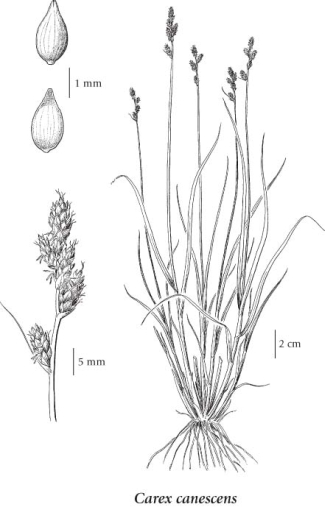Carex canescens L.
silvery sedge (Columbia sedge; grey sedge; white sedge)
Cyperaceae (Sedge family)
Introduction to Vascular Plants
silvery sedge (Columbia sedge; grey sedge; white sedge)
Cyperaceae (Sedge family)
Introduction to Vascular Plants
SUBTAXA PRESENT IN BC
Species Information
General:
Perennial, somewhat tufted herb from elongate, fibrous roots; stems 20-60 cm tall, sharply triangular, rough below the inflorescence, about as long as the leaves.
Leaves:
Sheaths tight; blades numerous, borne on the lower part of the stem, 2-3 mm wide, flat.
Flowers:
Spikes 5 to 10 in a 3- to 5-cm long inflorescence, the upper closer together, egg-shaped, many-flowered, about 5 mm long, ascending, the lower few spikes separate, with both female and male flowers, the female flowers towards the tips, the male flowers inconspicuous; bracts reduced, only the lowermost bract sometimes awnlike, about 0.5-2 cm long.
Fruits:
Perigynia egg-shaped, 2.2-2.5 mm long, 0.8-1 mm wide, light green, minutely whitish-dotted, plano-convex, smooth, with several nerves, especially above, unstalked, the beaks short, 0.25 mm long, smooth, not cleft; female scales egg-shaped, almost covering the perigynia, pointed, green, with green midribs; stigmas 2; achenes lens-shaped, 1.2-1.5 mm long, filling the perigynia.
Illustration

If more than one illustration is available for a species (e.g., separate illustrations were provided for two subspecies) then links to the separate images will be provided below. Note that individual subspecies or varietal illustrations are not always available.
Illustration Source: The Illustrated Flora of British Columbia
USDA Species Characteristics
Flower Colour:
Green
Blooming Period:
Late Spring
Fruit/Seed characteristics:
Colour: Brown
Present over the Summer
Source: The USDA
Ecology
Ecological Framework for Carex canescens
The table below shows the species-specific information calculated from
original data (BEC database) provided by the BC Ministry of Forests and Range.
(Updated August, 2013)
The table below shows the species-specific information calculated from
original data (BEC database) provided by the BC Ministry of Forests and Range.
(Updated August, 2013)
| Site Information |
Value / Class |
||
|
Avg |
Min |
Max |
|
| Elevation
(metres) |
1136 | 10 | 2280 |
| Slope
Gradient (%) |
2 | 0 | 70 |
|
Aspect (degrees) |
288 | 20 | 360 |
| Soil
Moisture Regime (SMR) [0 - very xeric; 4 - mesic; 8 - hydric] |
6 | 0 | 8 |
| Modal
Nutrient Regime
Class |
C | ||
| #
of field plots species was recorded in: |
272 | ||
| Modal
BEC Zone Class |
ESSF | ||
|
All BEC Zones (# of stations/zone) species was recorded in |
BAFA(1), BG(2), BWBS(6), CDF(6), CWH(38), ESSF(66), ICH(21), IDF(13), MS(47), SBPS(7), SBS(55), SWB(3) | ||
|
Source:
Klinkenberg 2013
|
|||
Habitat and Range
Bogs, swamps, fens, wet meadows and streambanks in all but the alpine zone; common in S BC, less frequent northward; circumpolar, N to AK, YT and NT, E to Labr. and NF and S to ME, PA, WV, IN, MN, WI, SD, NM, AZ and CA; Greenland, Iceland, Eurasia, S America, Australia, New Guinea.Synonyms
Synonyms and Alternate Names:
Carex cinerea